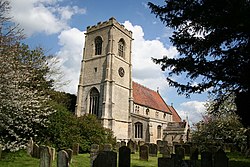Stickney
| Stickney | |
| Lincolnshire | |
|---|---|
 St Luke's Church, Stickney | |
| Location | |
| Grid reference: | TF343566 |
| Location: | 53°5’25"N, -0°0’18"E |
| Data | |
| Population: | 1,127 (2011) |
| Post town: | Boston |
| Postcode: | PE22 |
| Dialling code: | 01205 |
| Local Government | |
| Council: | East Lindsey |
| Parliamentary constituency: |
Boston and Skegness |
Stickney is a linear village in the fenland in the veery south of Lindsey, the northern part of Lincolnshire. The village stretches along the A16 Boston to Lincoln road, closely confined between the East Fen Catchwater Drain and the West Fen Catchwater Drain.
This was an ancient parish but always small; its population has increased since late 20th-century immigration and was recorded as 1,127 in 2011.
Location and transport
Stickney is situated at the centre of the Lincolnshire Fens, eight miles north of Boston and ten miles south-east of Horncastle.
The village is on a main bus route between Spilsby and Boston, which runs along the A16. It used to be served by an east-west railway line, but this closed in 1970. A transmitting station is located near Stickney Camp Site to the north
Parish church and charity
The ancient parish church, St Luke, was built in the 13th century and it is a Grade II listed building. The parish was created in the flush of the Reformation, in 1564.[1]
A new chancel was built in 1853 and the rest of the church was restored in 1855. The tower was partly taken down in 1887 because of deterioration, but rebuilt in 1900.
Donations to the poor house and for care of the poor have been recorded since 1552 when William Hardy left a yearly rent charge of £1 6s. 8d. for the poor of the parish.[2]
History
The name 'Stickney' is first attested in the Domesday Book of 1086, where it appears as Stichenai. The name means 'stick island', and is thought to refer to the linear shape of the village between two streams. The nearby Stickford similarly means 'stick ford'.[3]
Stickney has been chiefly an agricultural community.
Stickney Church of England Primary School serves local children. Some progress to regional grammar schools, and others to the William Lovell Church of England Academy, the former William Lovell Secondary School, on Main Road. Lovell had established a free school in the parish in 1678. After the school was enlarged in 1879, pupils began paying an annual fee of £1 in 1881.
Local amenities have included a public house, the Rose and Crown House on the main road, which operated for about 100 years. As of 2012 it had closed and was for sale. The village has a miniature railway and a fish and chips shop. The post office doubles as a general store.
Stickney publishes a monthly Stickney Parish Magazine.
Local murder
Stickney was the home of Priscilla Biggadike, who in 1868 was charged and convicted of murdering her husband Richard by arsenic poisoning. They lived in a small two-room house with their five children and two lodgers. She testified that she had seen one of their lodgers, Thomas Proctor, putting a white powder into her husband's tea, and later into his medicine when Richard was being treated for a sudden attack of severe illness.
At first, the two were both suspects, as they were rumoured to be having an affair. The judge in the case ruled that only Priscilla Biggadike should be prosecuted, and the jury quickly convicted her. She was executed in December 1868. Years later on his deathbed, Proctor confessed to sole responsibility for the murder of Richard Biggadike.
Outside links
| ("Wikimedia Commons" has material about Stickney) |
- Primary school
- Stickney History; stickneyhistory.co.uk
- William Lovell CE Secondary Modern School
References
- ↑ "St. Luke's Church, Stickney", Explore Lincolnshire
- ↑ Stickney: Lincolnshire GenWeb
- ↑ Ekwall, Eilert, The Concise Oxford Dictionary of English Place-Names. Oxford, Oxford University Press, 4th edition, 1960. p. 442 ISBN 0198691033